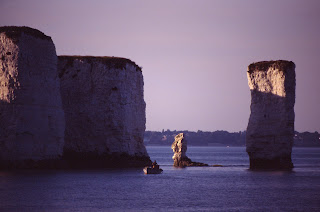All through the War the Cinema industry did rather well, and now it's all over the queues are as long as ever. For those lucky to be alive there are ever greater films to experience. Thrilling World War Two dramas for instance, complete with aeroplanes and all the other props lying about. However, as the fifties dawn a new enemy is beginning to emerge, more terrifying than Adolf. No, not the Bomb, or even Reds under the Bed, both of which will spawn new movies.
SomeTHING else is about to take over the world....
Television.
In Hollywood they worry.
"Just how do we get people out their cosy homes and back to those drafty cinema queues ?" ie. my English translation. Probably should be "goddamn line"?
Then, somebody at Twentieth Century Fox has an idea.... He remembers that back in the twenties, long before the war, a French professor called Henri Chretien had come up with a strange lens. It squeezed more information into the film image horizontally to give a panoramic effect on the screen when projected using a similar lens. The studio bosses hurry over to France to buy it from the old man who has been largely ignored up to now. Why the rush? Because people from Warner Brothers are hot on their heels... but they miss the deal by a few hours.
Fox is about to start shooting a new biblical epic called "The Robe", so it is decided to simultaneously film it using another camera fitted with Chretien's lens. Highly experimental stuff, not least because it needs a new filming technique. But will the cinemas accept the new (actually 1920s !) technology ? They will have to also use this strange "anamorphic" lens as well as providing a much wider screen. The gamble pays off. CinemaScope is born.

Before long, everybody wants widescreen and CinemaScope... "the modern miracle you see without glasses" implying it's 3D which of course it's not, though curving the screen does help the illusion. New lenses are produced that use the same compression factor of 2x, under a multitude of names... such as Panavision, still greatly used today. There have been many other widescreen or panoramic processes, like Cinerama which came slightly earlier than CinemaScope, but the Scope anamorphic system has proved the most popular mainly because it is comparitively cheap. Also easy on the projectionist.
So in the early 1950s the classic 4 by 3 image is transformed overnight to 2.66 to 1 ratio. Even normally shot 35mm films are masked top and bottom to try and capitalise on the public's new thirst for Widescreen. At the same time, stereo sound is entering the arena. To make room for the extra sound tracks the CinemaScope frame is narrowed slightly (2.55: 1 ratio), and much later ends up at 2.35 : 1. But nobody seems to notice. The enveloping panoramic effect is still there and improved sound quality fills in the gaps.
So what happened to our old friend Sixteen Mil ?
Like 35mm, Sixteen was born with the classic 4 x 3 picture. That was way back in 1923, when it was intended solely as an amateur format. But during the war 16mm was used extensively by professional cameramen even with colour film. (Did you see the recent TV programme ?) After the war 16mm becomes very popular for showing films including reduction prints from 35mm.... and yes, Scope. So it's not very long before Chretien's lens is plonked in front of the 16mm projector-lens. Unfortunately, except for Arc-lamp projectors, the light output suffers because of the increased size of screen.
And for filming ? Why of course ! The same lens does it all.
Bolex and other manufacturers introduce special adaptors to suit their cameras. At first they are not too popular with film-makers. Perhaps because of that light problem ? Showing a small letter-box picture doesn't do justice to a Scope movie. Take a look at the "Robe" image above: Richard Burton must be in there somewhere ! Click on it, see what I mean ?
It will be years later in the late 1960s and 70s when much brighter projectors are developed for 16mm.

Unlike 35mm, 16mm CinemaScope retains its image shape of 2.66 to 1. On the screen that is. However, when showing reduction prints from 35mm the projected image is slightly narrower at 2.35 : 1. The one standard that has survived to this day is the 2x compression factor of the anamorphic lens, as the image is filmed or expanded on projection. Other lenses like the Iscorama were introduced with 1.5x compression, but they remain non-standard.
Final thoughts...
If TV had not reared its head in the fifties, would Chretien's lenses have ended up on a rubbish tip ?! Also, now TV is racing to become more and more like cinema, with Hi-def widescreen and surround sound, will Cinema sadly fade away ? Or right now is someone in Hollywood maybe saying: "I've got an idea..."























